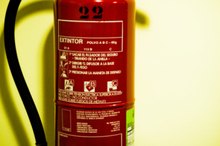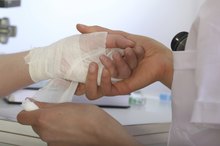What does fact checked mean?
At Healthfully, we strive to deliver objective content that is accurate and up-to-date. Our team periodically reviews articles in order to ensure content quality. The sources cited below consist of evidence from peer-reviewed journals, prominent medical organizations, academic associations, and government data.
The information contained on this site is for informational purposes only, and should not be used as a substitute for the advice of a professional health care provider. Please check with the appropriate physician regarding health questions and concerns. Although we strive to deliver accurate and up-to-date information, no guarantee to that effect is made.
Muriatic Acid Burn Injury Treatment
Muriatic acid is another name for hydrochloric acid, which is a highly corrosive, poisonous liquid produced when hydrochloride, a gas, is mixed with water. It’s used in various manufacturing processes (in photograph processing and tanning leather, for example), and as a toilet bowl antiseptic, according to the Missouri Department of Health. It can severely burn throat, stomach, nasal and skin tissue when inhaled, swallowed or spilled.
Skin Burns
Flush the contaminated areas with water. High concentrations of vapor or liquid can cause the skin to redden and blister. In extreme cases, it can trigger frostbite, kill tissue or deeply ulcerated burns, the North Carolina Department of Health warns. Flush affected skin with water for 15 minutes but don’t apply soap or rub it. Remove any clothing or jewelry that may have come into contact with the chemical and seek medical advice.
- Flush the contaminated areas with water.
- In extreme cases, it can trigger frostbite, kill tissue or deeply ulcerated burns, the North Carolina Department of Health warns.
Eye Burns
The Symptoms of Freon Exposure
Learn More
Exposure to eyes can irritate and burn or cause swelling, tearing, blurred vision, sensitivity to light and blindness. Like skin, eyes should also be flushed with water for 15 minutes. Lift the upper and lower lids while doing so. If the victim wears contact lenses, make sure they are removed. Seek medical advice if necessary.
- Exposure to eyes can irritate and burn or cause swelling, tearing, blurred vision, sensitivity to light and blindness.
- Like skin, eyes should also be flushed with water for 15 minutes.
Inhalation
Move the victim to fresh air and monitor respiration. Breathing in toxic amounts of this chemical will cause congestion, coughing and a burning sensation in the throat. Move the victim away from the accident scene into fresh air. Check for breathing irregularities and conduct CPR if necessary.
- Move the victim to fresh air and monitor respiration.
Ingestion
The Effects of Muriatic Acid
Learn More
Force fluid intake and call for expert advice. Swallowing hydrochloric acid will quickly trigger severe pain in the mouth, throat, chest and abdomen, and can trigger nausea and vomiting. Get the victim to drink large amounts of water or milk to dilute the chemical’s strength, but do not force him to vomit unless told to do so by a physician. Call the National Capital Poison Center (800-222-1222) and seek immediate medical attention.
- Force fluid intake and call for expert advice.
- Get the victim to drink large amounts of water or milk to dilute the chemical’s strength, but do not force him to vomit unless told to do so by a physician.
Types of Burns
Gauge the burn's severity, if you're capable of doing so before seeking direct medical intervention. It's a good idea to check with a physician if any symptoms occur (and in all cases involving someone who's swallowed hydrochloric acid). But minor exposure (short term, in small concentrations) to corrosive chemicals may only damage the top one or two layers of skin, causing first- or second-degree burns, many of which will heal on their own, according to the National Institutes of Health 1. In these cases, loosely covering the wound with sterile gauze after it's been thoroughly flushed clean with water will help to protect it until the tissue heals. Third-degree burns (which penetrate all skin layers and the tissue underneath) can cause massive, permanent damage, tissue death and scarring. These burns need to be treated with topical and potentially oral or injected antibiotics to prevent possible serious infection. In extreme cases, it may be necessary to surgically replace lost tissue with skin grafts. If in doubt about the severity of the injury, consult a physician.
- Gauge the burn's severity, if you're capable of doing so before seeking direct medical intervention.
- But minor exposure (short term, in small concentrations) to corrosive chemicals may only damage the top one or two layers of skin, causing first- or second-degree burns, many of which will heal on their own, according to the National Institutes of Health 1 can cause massive, permanent damage, tissue death and scarring.
Related Articles
References
Writer Bio
Barbara Bryant has been writing professionally for 25 years. She has contributed to "The Military Engineer" and ASCE's "Civil Engineering" magazines as well as many other publications. Through newsletters and blogs, Bryant specializes in health and fitness topics, drawing on expertise from personal trainers and a naturopathic doctor.









